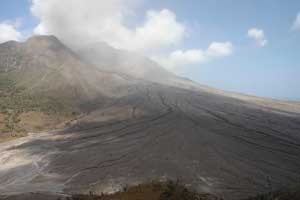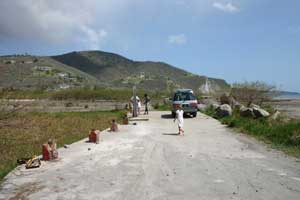Montserrat - 15 May

Dearloves
Wed 17 May 2006 16:10
|
We are anchored towards the north end of the island of Montserrat, away
from the volcano. Little Bay, where we are, is the only port of entry for
visiting yachts, and one of the few anchorages that we are permitted to
use. It is not particularly protected and we have had to anchor a long way
from the shore, in 17 metres of water, to avoid reefs and moored boats. We
have all 70 metres of our anchor chain out and are swinging in a wide arc as
gusts of wind hit us from different directions anywhere between NE and SE.
 View from Keoma
Today we took a taxi tour of the island, in particular the area near the
volcano. It is still active, after 10 years, although considered to be
quietening down. As we headed south from our anchorage there was not
really any evidence of the volcano. Things seemed surprisingly
normal. We passed small communities and schools, sports grounds and the
government offices. Everything seemed a little dusty and some of the trees
and plants looked a bit unhappy. There was certainly no sign of downcast
spirits amongst the people we met.
As we came into the exclusion zone we passed a sign by the roadside:
 For full text, see footnote
We came to a river of ash. Our driver told us that this was around 30
feet above the height of the land there previously.
We walked up a hill to get a better view of the lava flows.
They were like a moonscape:
 Lava flows with volcano erupting ash in the
background
When we looked closer, we could see houses buried in the ash, in some
places. In other places the ash was estimated to be 300 metres deep, so
everything in its path was engulfed. One of the homes below has just its
roof above the ash level. Another has its roof missing - apparently many
of the building materials, including the glass windows, just melted away.
 The scene was totally chilling and we were shocked by the hopelessness of
it. Our emotions were similar to when we witnessed the devastation of
Hurricane Ivan in Grenada, although there was a great feeling of regeneration
there. Most people had mended their roofs and repaired their homes and
were still living in them. Here the people will never return to their
homes. Even if the exclusion zone is lifted, it is widely acknowledged
that they will not go back, and it is likely that their children and
grandchildren will not return to these homes within their lifetimes.
We went inside one house on a hill above Plymouth. There were clothes
in the wardrobes and the beds were still made. It looked as though the
owners of the house had left on a moment's notice.
Looking at Plymouth, once the capital of the island, it is a ghost town,
reminiscent of the images we saw of Chernobyl from a few years ago.
All foliage has been burnt away by the acid rain. The once colourful
Caribbean houses lie beneath a thick coating of ash. We saw a church
that is now just a spire, it is so deeply buried. The town had a rice
packing factory and an electronics factory, both now destoryed. The cruise
ship dock is mainly inland, such has been the silting up of the
waterfront. There is now no industry and no tourism (other than a few
visitors on yachts), not only for the area of the volcano but for the entire
island.
 Plymouth
We stopped off in Old Road Bay, as this is an anchorage which is sometimes
outside the exclusion zone for yachts. As we drove in, we realised that we
were driving along the old dock - the red posts along the left are cleats for
tying up your boat. However, it is totally land-locked now and the land
extends for at least 30 metres beyond what would have been the seaward side of
the dock.
 Old Road Bay Dock
We had lunch at a local restaurant. The food was great and the
service was brilliant. The people we met there were charming. A
local lady came up to Alice and said she was "as brown as a doughnut." It
was hard to reconcile their attitude with the physical destruction a few
miles away, and its effect on the island's economy and infrastructure. We
came back to the boat in a very reflective frame of mind.
FOOTNOTE:
The Full Text of the Roadside Sign reads:
"WARNING
You are about to enter an area that is dangerous. You should proceed
with extreme caution. Although volcanic activity is currently at a low
level other dangers persist in the former Day Time Entry Zone.
The dangers include high levels of ash and lack of utilities (no water,
electricity, street lighting or telephones in this area). If you travel on
foot to the former DTEZ, it is advisable to carry dust masks with you.
The road network is in a poor state of repair with some roads severely
damaged and dangerous to travel on. Many houses are also in a poor state
or repair and may be dangerous to enter.
Areas now available for 24 hours access include Cork Hill, Delvins Weekes,
Elberton, Foxes Bay, Richmond Hill. In addition a small day time
Entry Zone exists at the top of St Georges Hill.
Access to the Exclusion Zone, including the former capital Plymouth is
still not permitted.
If you decide to enter the former DTEZ it is advisable to have a mobile
telephone with you. In the event of an emergency call the Fire and Rescue
Service on the Telephone no 491-7790.
Government of Montserrat."
|